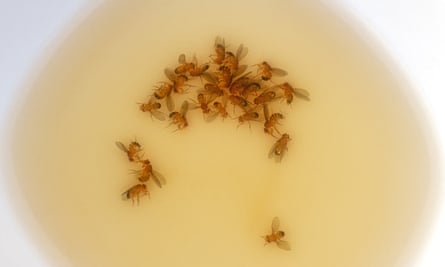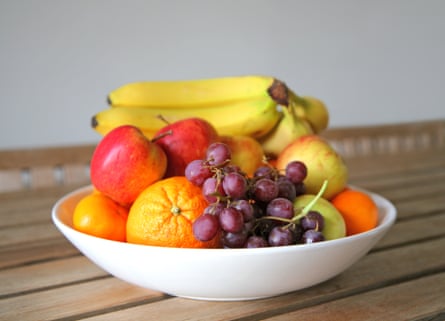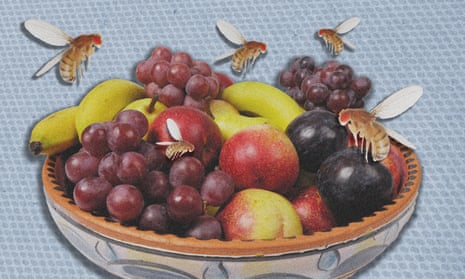Most of us are familiar with the pesky little flies that hover around fruit bowls and food scraps or get tipsy floating in a glass of beer or wine. What is less commonly known is that these little bugs are NOT fruit flies: they’re vinegar flies (Drosophila melanogaster), otherwise known as ferment flies.
Some people may not even recognise “true” fruit flies – the ones that decimate orchards and threaten Australia’s $16.25bn horticulture industry – because they’re bigger than the vinegar fly they’re commonly mistaken for.
“Vinegar flies are tiny flies about the size of a pinhead and have red eyes,” says Dr Brendan Missenden, senior entomologist at Queensland’s Department of Agriculture and Fisheries. “Whereas true fruit flies are about the size of a housefly, so they’re quite solid and chunky. Some people think they’re wasps because they’re brightly coloured with patches of yellow and patterned wings.”

Know your flies
It’s important to know the difference, because real fruit flies can appear in back yards and even in fruit bowls and need to be reported immediately. Not only can outbreaks cripple the fruit industry and farmers’ livelihoods, if not detected you might bite into a fresh-looking piece of fruit and find it full of maggots.
“It’s important, from a biosecurity perspective, for people to name them correctly, then they know what they’re dealing with so they do the right thing – there are different control measures for different species,” says Dr Darryl Hardie, AKA Dr Bug-A-Lugs, an entomologist and consultant for Western Australia’s Department of Primary Industries and Regional Development.
Australia has more than 300 species of fruit fly but two cause the economic destruction: the Queensland fruit fly (Qfly; Bactrocera tryoni), which appears mostly down the east coast, and the Mediterranean fruit fly (Medfly; Ceratitis capitata), found largely in WA.
Hardie explains that the females attack immature fruit on the tree to lay their eggs inside, which hatch into larvae (maggots) and cause fruit rot, while vinegar flies are attracted by fruit that is already rotting.
If you buy fruit containing the real fruit fly, you might notice a large pupae (cocooned larvae) in the bottom of your fruit bowl or even near a skirting board, as maggots leave the fruit and pupate for about a week before they emerge as a fly. “So you can get the economic species,” says Hardie, “but they won’t usually reinfest anything in the bowl. They’ll just try to find a mate and get out.” Vinegar flies, on the other hand, like to hang around and keep reproducing.
Eradicating vinegar flies

Fortunately, internet hacks to get rid of the so-called fruit fly, alias vinegar fly, are largely sound. The most popular, cheap and easy method is to put about an inch of apple cider vinegar in a glass or bowl with dishwashing liquid.
This is Missenden’s trap of choice. The fermented vinegar smells like rotting fruit and attracts the flies, he explains, then the detergent causes them to drown. “Some insects can walk along water, and a drop of detergent just breaks the water surface so their legs don’t hold them up and they sink to the bottom.”
after newsletter promotion
You may need to do this several times to catch ones that are still at egg or larvae stage – their life cycle ranges between seven and 19 days. For best results, remove other fermenting products such as ripe fruit, food scraps or glasses containing leftover wine or beer. In short, keep your kitchen clean and dishes washed.
This can also help prevent them – always better than cure. Vinegar flies can get out of control very quickly. “Often the vinegar flies seem to just spring up overnight,” Missenden says. “You only need a couple to create a fairly big population very quickly.”
To keep the vinegar flies away, the best hack, according to Thanh Truong, AKA Fruit Nerd, is to store your fruit correctly. His advice, detailed in the book Don’t Buy Fruit & Veg Without Me! will also help to keep fruit fresher and tastier.

To slow fruit ripening, he says ditch the fruit bowl. The more fruits that are stacked on top of each other, the greater the buildup of gases and the faster they will ripen. You are also more likely to miss fruit that has become overripe or damaged. Any fruit that is ripening should be eaten or put straight in the fridge.
Thick-skinned fruit such as mangoes are less vulnerable to vinegar fly, while thin-skinned fruit such as bananas are prime targets. “Putting bananas next to apples or pears is a really bad idea,” says Truong, “because they release so much ethylene that the banana will have half its shelf life.” So if you can’t bear to part with your fruit bowl, he says half the battle is won just by storing bananas separately.
“Fruit is alive, and if you see it as a commodity you’re never going to be able to battle this, because you’re watching fruit as it ripens, as it’s changing physiologically, and the insects and nature are responding in the same way.”

Comments (…)
Sign in or create your Guardian account to join the discussion